[Pic 1 AS IS] [Pic 2 TO BE]
[Pic 2 TO BE]
Hi there, I am just starting to learn Swift an I would like my app users to build their own list of items (first level) where each item again contains a list of items (second level). Important is that each of the individually created lists in the second level is like no other of the individually created lists. (see picture)
Is anyone aware of which approach I need to take to solve this?
I am myself able to build the list within the list within the NavigationView, but how can I make each list individual?
Here is my code:
struct ItemModel: Hashable {
let name: String
}
struct ProductModel: Hashable {
let productname: String
}
class ListViewModel: ObservableObject {
@Published var items: [ItemModel] = []
}
class ProductlistViewModel: ObservableObject {
@Published var products: [ProductModel] = []
}
struct ContentView: View {
@StateObject private var vm = ListViewModel()
@StateObject private var pvm = ProductlistViewModel()
@State var firstPlusButtonPressed: Bool = false
@State var secondPlusButtonPressed: Bool = false
var body: some View {
NavigationView {
List {
ForEach(vm.items, id: \.self) { item in
NavigationLink {
DetailView() //The DetailView below
.navigationTitle(item.name)
.navigationBarItems(
trailing:
Button(action: {
secondPlusButtonPressed.toggle()
}, label: {
NavigationLink {
AddProduct() //AddProduct below
} label: {
Image(systemName: "plus")
}
})
)
} label: {
Text(item.name)
}
}
}
.navigationBarItems(
trailing:
Button(action: { firstPlusButtonPressed.toggle()
}, label: {
NavigationLink {
AddItem() //AddItem below
} label: { Image(systemName: "plus")
}
})
)
}
.environmentObject(vm)
.environmentObject(pvm)
}
}
struct AddItem: View {
@State var textFieldText: String = ""
@Environment(\.presentationMode) var presentationMode
@EnvironmentObject var vm: ListViewModel
var body: some View {
NavigationView {
VStack {
TextField("Add an item...", text: $textFieldText)
Button(action: {
vm.addItem(text: textFieldText)
presentationMode.wrappedValue.dismiss()
}, label: {
Text("SAVE")
})
}
}
}
}
struct DetailView: View {
@StateObject private var pvm = ProductlistViewModel()
@Environment(\.editMode) var editMode
var body: some View {
NavigationView {
List {
ForEach(pvm.products, id: \.self) { product in
Text(product.productname)
}
}
}
.environmentObject(pvm)
}
}
struct AddProduct: View {
@State var textFieldText: String = ""
@Environment(\.presentationMode) var presentationMode
@EnvironmentObject var pvm: ProductlistViewModel
var body: some View {
NavigationView {
VStack {
TextField("Add a product", text: $textFieldText)
Button(action: {
pvm.addProduct(text: textFieldText)
presentationMode.wrappedValue.dismiss()
}, label: {
Text("SAVE")
})
}
}
}
}